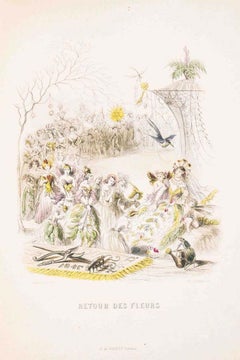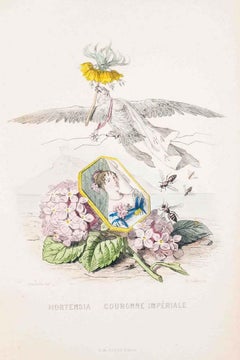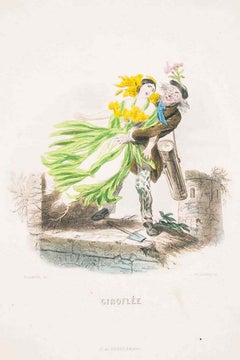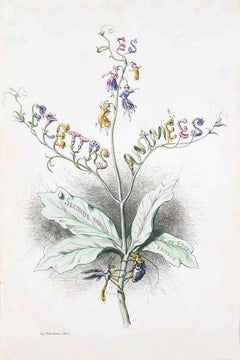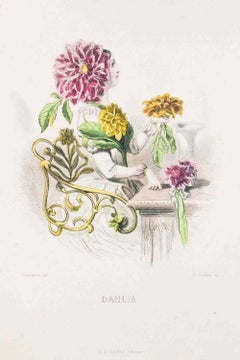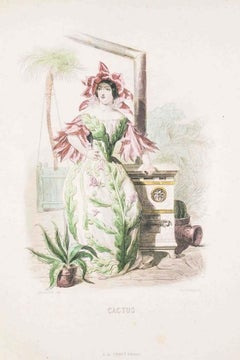1840s Figurative Prints
to
3
496
229
4
Overall Width
to
Overall Height
to
681
7
2
1
30
24
7
7
7
3,646
7,634
25,377
6,783
290
603
1,427
1,220
1,240
2,186
3,115
5,310
2,937
1,428
3,106
506
220
3
510
232
232
148
107
100
78
74
74
59
41
36
33
30
30
24
24
21
19
19
589
107
19
19
17
6
663
644
17
Period: 1840s
Retour des Fleurs - Les Fleurs Animées Vol. II - Litho by J.J. Grandville - 1847
Located in Roma, IT
Image dimensions: 24.3 x 17.5 cm.
Single sheet with passepartout.
"...The unhappy man had approached that mysterious spot where, amid a thousand aquatic plants, the Water-arrow gr...
Category
Modern 1840s Figurative Prints
Materials
Lithograph
Hortensia Couronne Impériale - Les Fleurs - Lithograph by J.J. Grandville - 1847
Located in Roma, IT
Image dimensions: 24.3 x 17.5 cm.
Single sheet with passepartout.
"...The unhappy man had approached that mysterious spot where, amid a thousand aquatic plants, the Water-arrow gr...
Category
Modern 1840s Figurative Prints
Materials
Lithograph
Giroflée - Les Fleurs Animées Vol.II - Lithograph by J.J. Grandville - 1847
Located in Roma, IT
Image dimensions: 24.3 x 17.5 cm.
Single sheet with passepartout.
"...The unhappy man had approached that mysterious spot where, amid a thousand aquatic plants, the Water-arrow gr...
Category
Modern 1840s Figurative Prints
Materials
Lithograph
Frontispiece - Les Fleurs Animées Vol.II - Lithograph by J.J. Grandville - 1847
Located in Roma, IT
Image dimensions: 24.3 x 17.5 cm.
Single sheet with passepartout.
"At a crossing in the forest, where four roads unite, a number of flowers happened to meet - among which were seen the Cactus, the Peach-blossom, the Dahlia, the Sensitive-plant, the Fuchsia, the Periwinkle, and the Sweet-scented Pea." T. Delord.
Les Fleurs animées...
Category
Modern 1840s Figurative Prints
Materials
Lithograph
Dahlia - Les Fleurs Animées Vol.II - Lithograph by J.J. Grandville - 1847
Located in Roma, IT
Image dimensions: 24.3 x 17.5 cm.
Single sheet with passepartout.
"...weary of being followed round by old bachelors, who clasp me by the waist, and call me Flora's priestess, I have resolved to flee from mankind, and to return to my old condition - that of a simple flower." T. Delord.
Les Fleurs...
Category
Modern 1840s Figurative Prints
Materials
Lithograph
Cactus - Les Fleurs Animées Vol.II - Lithograph by J.J. Grandville - 1847
Located in Roma, IT
Image dimensions: 24.3 x 17.5 cm.
Single sheet with passepartout.
"...The entire history of my life on earth may be summed up in four words - I have been cold." T. Delord.
Les Fl...
Category
Modern 1840s Figurative Prints
Materials
Lithograph
Bal - Les Fleurs Animées Vol.II - Lithograph by J.J. Grandville - 1847
Located in Roma, IT
Image dimensions: 24.3 x 17.5 cm.
Single sheet with passepartout.
"Delighted at finding themselves again united, after all theit vicissitudes, the chief flowers determined on givi...
Category
Modern 1840s Figurative Prints
Materials
Lithograph
Lesti, Lesti al Timone - Hand Watercolored Lithograph by A. Masutti - 1848
Located in Roma, IT
Lesti, Lesti al Timone is a beautiful hand-watercolored lithograph, realized in1848 by the Italian satirical artist Antonio Masutti (Aviano 1813-Tourin 1895).
Title is printed in c...
Category
1840s Figurative Prints
Materials
Lithograph
Monsieur Par suite De La Fusion... - Lithograph by H. Daumier - 1845
Located in Roma, IT
Image dimensions: 23 x 19 cm.
Monsieur Par suite De La Fusion... - From “Les philanthropes du jour” is an original artwork realized by Honoré Daumier in 1845/46.
Original complete ...
Category
Modern 1840s Figurative Prints
Materials
Lithograph
Salvator Rosa at the Brigands - Original Litho by A.P. Riffaut After Guignot
Located in Roma, IT
Salvator Rosa at the Brigands is an original artwork realized by Adolphe Pierre Riffaut in 1844. Original lithograph on paper after A. Guignot.
Artist's proof before Letter. Passepa...
Category
1840s Figurative Prints
Materials
Lithograph
L'Homme in naturalibus
Located in New York, NY
Honore Daumier (1808-1879), L'Homme in naturalibus, lithograph, from the Robert Macaire 2nd series, plate number 17. Published 1840-41. In generally good condition; a tiny hole lowe...
Category
1840s Figurative Prints
Materials
Lithograph
Yoshikazu Utagawa - Yoshinaka and the Shitenno Confront a Serpent at Okuyama
By Yoshikazu Utagawa
Located in BRUCE, ACT
Yoshikazu Utagawa (active circa 1850 - 1870)
Yoshinaka and the Shitenno Confront a Serpent at Okuyama
This is the middle panel of three
c. 1844 - 1848
Oban
Good impression and ...
Category
1840s Figurative Prints
Materials
Woodcut
Recently Viewed
View AllMore Ways To Browse
Edmund F Ward
Edna Manley
Eduardo Roca
Edward B Gay
Edward Hopper Oil Painting
Edward Simmons
Edwin Lord Weeks
Elizabeth Enders
Elizabeth Horning
Emil Holzhauer
England Church Oil Painting
English Deer Painting
English Fox Hunt Painting
English Toy Terrier
Enrique Martinez Celaya
Eric Aho
Eritrea Art
Ernest Chateignon
